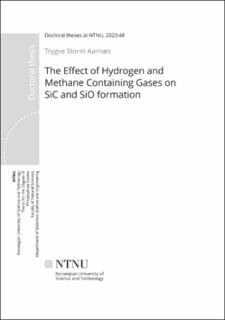| dc.description.abstract | The production of silicon is currently done in a submerged arc furnace where quartz react with carbon. This emits large amounts of CO2to the atmosphere. From a global warming perspective this is far from ideal, and international goals such as the Paris agreement puts emphasis on reducing the CO2 emissions from industry. In this process carbon is used as the reductant. Thus, for the process to not emit CO2the reductant must be substituted for a CO2neutral alternative. An example is hydrogen, which releases water instead of CO2. Another example is bio-gas, which only emits the amount of CO2that was removed from the atmosphere to produce it. Both of these reductants are gases, and silicon production as we know it is only equipped to use solid raw materials. In order to use these raw materials, they must first be understood in the context of silicon production. The work presented in this thesis aims to be a step on this path.
SiO gas is an important intermediate during silicon production, its role is to react with carbon and produce SiC, which is needed in a later reaction step. This work has investigated if instead of conventional solid carbon materials, a gaseous one can be used instead. Experiments were done with gas mixes of argon, hydrogen, methane and CO at 1650 ᵒC and 1750 ᵒC. An issue with using methane or other gaseous hydrocarbons at these temperatures is that they are not thermodynamically stable, and can potentially deposit carbon instead of reacting in a process known as cracking. This was not an issue and only small amounts of cracking was observed in this work. It was found that methane reacts very easily and rapidly with SiO and produces SiC. CH4 contents up to 8 % were used mixed with H2. The CH4 yield was very high, during some experiments it was measured as high as 100 % for a gas mix containing 5 % and 8 % CH4 mixed with H2.
The SiC formation was very sensitive to the specific conditions. Variations in temperature, methane content and gas composition affected the SiC structure. At 1650 ᵒC one of the main products was SiC whiskers. A formation mechanism was suggested where these whiskers initially form as SiC-SiO2 core shell whiskers, but that the shell layer is removed after the whisker has formed. Whisker formation occurred mostly in atmospheres rich in hydrogen, and to a lesser extent when CO was added to the setup. The raw material used in this work was mixed SiO2/SiC pellets, it was found that in atmospheres rich in both CO and hydrogen, SiC whiskers would form within the pellets in a way that dramatically increased their strength. In addition, a variety of other SiC structures formed such as crystals, needles, plates and ribbons.
The SiO generator was mixed pellets of SiO2 and SiC. When these pellets are heated they release SiO and CO gas. In this work SiO formation was investigated in argon, hydrogen, methane and CO atmospheres. The reaction was investigated by analysing the pellets before and after each experiments and measuring how the relative amounts of SiO2 and SiC changed. The reaction was found to proceed with faster kinetics in atmospheres containing hydrogen. This was attributed to the formation of water, which provided a new reaction mechanism between SiO2 and SiC that has enhanced kinetics. Additionally, the crucible, which was made from carbon, became far more reactive towards SiO2 when H2 was present. This effect is also attributed to the formation of water. A mechanism is suggested where first SiO reacts with the crucible and forms a surface layer of SiC, which then reacts with SiO2 through the same reaction occurring in the pellets. The reaction between SiO2 and the crucible, which occurs in the presence of H2 is suppressed by adding CO to the setup. Additionally, CO caused more of the SiC from the raw material to remain unreacted, and when used in combination with hydrogen it also significantly reduced the net reaction rate to a much greater extent than was seen without the presence of H2.
The current view is that the reaction between SiO2 and SiC is fairly well understood. It is expected that two moles of SiO2 reacts with one mole of SiC. If there are side reactions with carbon occurring, the ratio of reacted SiO2 and reacted SiC can be above two, but it should never be lower. However, for the current experimental work this was not what was observed. Almost every experiment with argon yielded ratios lower than two, with some experiments yielding ratios below 1.5. These results do not fit with the current view of the Si - O - C system, and indicates that this reaction might be less well understood than previously assumed. There could even be undiscovered silicon containing gas species forming and leaving the crucible.
The findings from this thesis aims to be a step out of the Si - O - C system, and into the Si - O - C - H system. This work will point out several advantages of being in the Si - O - C - H system, such as faster reaction rates, a greater option of raw materials, improved control of the carbon reactivity and improved control over SiO gas. However, for the ultimate goal, silicon production from hydrogen, there are still many steps remaining. | en_US |
